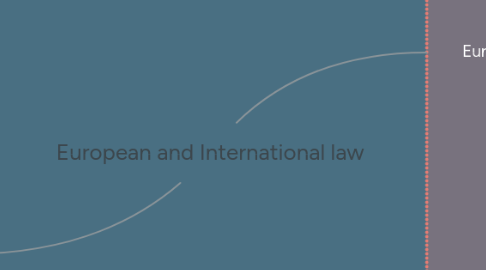
1. European law
1.1. Values
1.1.1. Democracy
1.1.2. Human dignity
1.1.3. Human rights
1.1.4. Equality
1.1.5. The rule of law
1.1.6. Freedom
1.2. History
1.2.1. WWII
1.2.1.1. Collaboration war countries
1.2.1.1.1. Economic cooperation
1.2.2. EEC
1.2.2.1. 6 countries
1.2.2.2. European economic community
1.2.2.3. Developed political union
1.2.2.4. 1958
1.2.3. EC
1.2.3.1. 1967
1.2.3.2. European community
1.2.3.3. Council and commission
1.2.3.4. 1970s expanding members
1.2.3.5. 1972 first elected european parliament
1.2.4. Creating EU
1.2.4.1. Treaty of Maastricht
1.2.4.2. 1992
1.3. Differences EU and UN
1.3.1. UN
1.3.1.1. Promotes cooperation
1.3.1.2. Peaceful relations
1.3.2. EU
1.3.2.1. One big nation out of many states
1.4. Sources
1.4.1. Treaty
1.4.1.1. Establishing the EU works
1.4.1.2. Based on the Rule of law
1.4.1.3. Formal written agreement
1.4.2. Regulation
1.4.2.1. Binding legislative act
1.4.3. Directive
1.4.3.1. Legislative act
1.4.3.2. Goals to reach for countries
1.5. Institutions of EU
1.5.1. European parliament
1.5.1.1. Budgetary
1.5.1.2. Legislative
1.5.1.3. Supervisory
1.5.1.4. Law-making body
1.5.2. European commission
1.5.2.1. General intrest
1.5.2.2. Proposes new laws
1.5.2.3. Manages EU policies and allocates EU funding
1.5.2.4. Enforces EU law
1.5.2.5. Represents the EU internationally
1.5.3. Council of ministers
1.5.3.1. Negotiates/adopts EU laws
1.5.3.2. Foreign and security policy
1.5.3.3. Concludes agreements
1.5.3.4. Adopts annual EU budget
1.5.4. European council
1.5.4.1. General political direction
1.5.4.2. Priorities
1.5.5. European court of justice
1.5.5.1. Interpreting law
1.5.5.2. Enforcing law
1.5.5.3. Annuling EU legal acts
1.5.5.4. Santionning EU institutions
1.6. UN in internation law
1.6.1. Single market
1.6.1.1. EURO
1.6.1.1.1. Compare prices
1.6.1.1.2. No inconvenience of changing currencies
1.6.1.2. What?
1.6.1.2.1. No restrictions on trade
1.6.1.2.2. Consequences for consumers
1.6.2. Functions
1.6.2.1. International court of justice
1.6.2.1.1. Settle legal disputes
1.6.2.2. Economical and social council
1.6.2.2.1. Coordination
1.6.2.2.2. Policy review
1.6.2.2.3. Policy dialogue
1.6.2.2.4. Recommendation on economic
1.6.2.3. Security council
1.6.2.3.1. Internation peace and security
1.6.2.4. General assembly
1.6.2.4.1. Representative
1.6.2.4.2. Policymaking
1.6.2.4.3. Deliberative
1.6.2.5. Secretariat
1.6.2.5.1. Day to day work
1.6.3. UN sustainable goals
1.6.3.1. Equality, good, healt, zero poverty, ...
1.6.3.2. Blueprint for sustainable future
1.6.3.3. Goal deadline 2019
1.6.3.4. Sustainable business
1.6.3.4.1. IKEA
1.6.4. Business agencies UN
1.6.4.1. WIPO
1.6.4.1.1. World intellectual property organisation
1.6.4.2. IMF
1.6.4.2.1. Promotes economic growth/employment
1.6.4.2.2. Temporary financial assistence
1.6.4.3. ITU
1.6.4.3.1. International telecommunication union
1.6.4.3.2. Information and communication technologies
1.6.4.3.3. Connecting people worldwide
2. International law
2.1. Enforce?
2.1.1. State responsibility
2.1.1.1. Principles
2.1.1.2. Breach of contract
2.1.1.3. International obligation
2.1.2. Mediation
2.1.2.1. Flexible and consensual
2.1.2.2. Third party
2.1.2.3. Settlements
2.1.2.4. Contractually binding
2.1.3. Arbitration
2.1.3.1. Independent moderator
2.1.3.2. Flexible/efficient
2.1.3.3. Dispute resolution
2.1.3.4. Financial and binding
2.2. Domestic law
2.2.1. Within border
2.3. Accross borders
2.4. Public or private
2.5. Why obey?
2.5.1. World peace
2.5.2. Benefits from compliance
2.6. Subjects
2.6.1. States
2.6.2. International organizations
2.6.3. Non-state entities
2.6.4. Individuals
2.7. Sources
2.7.1. Treaties
2.7.1.1. Two or more states
2.7.1.2. Agreement
2.7.1.3. Binding
2.7.2. Customs
2.7.2.1. Traditions/conventions
2.7.3. General principles of law
2.7.3.1. Basic rules
2.7.3.2. General and abstract content
2.7.4. Judicial decisions and writings of publicists
2.7.4.1. Non binding
2.7.4.2. Guide to content
2.7.5. Hard law vs. soft law
2.7.5.1. Hard law
2.7.5.1.1. Legal obligations
2.7.5.1.2. Binding
2.7.5.2. Soft law
2.7.5.2.1. Agreements/principles/declarations
2.7.5.2.2. Not binding
